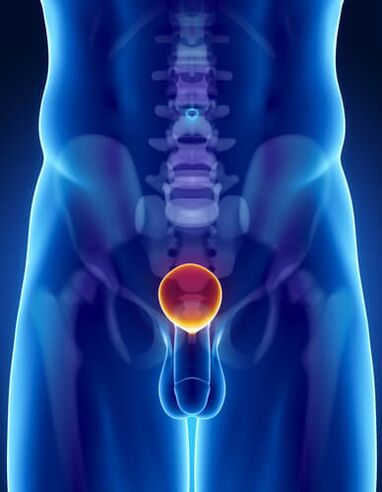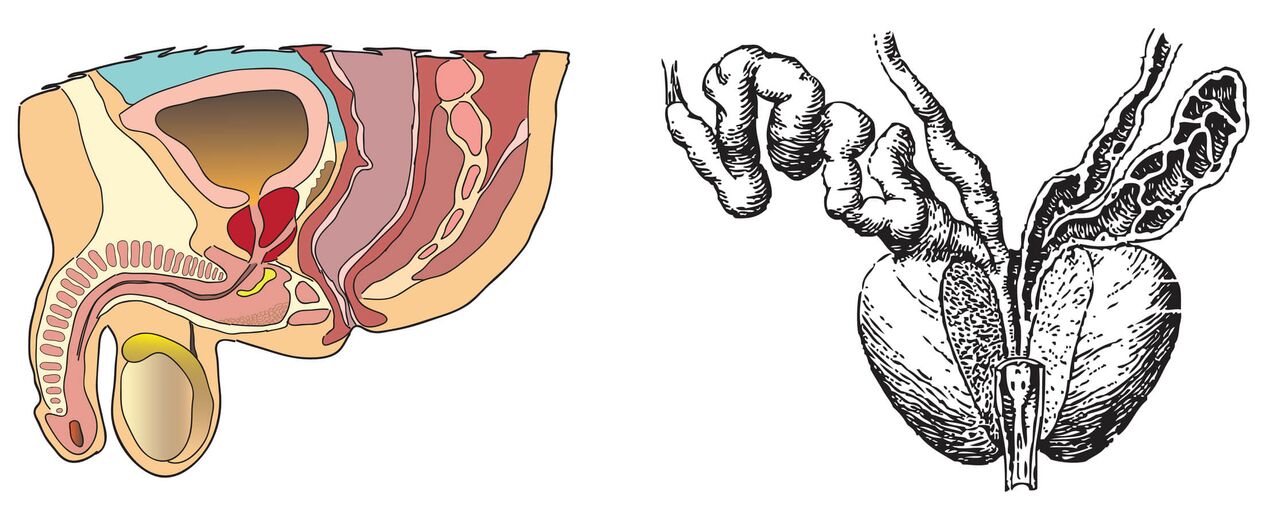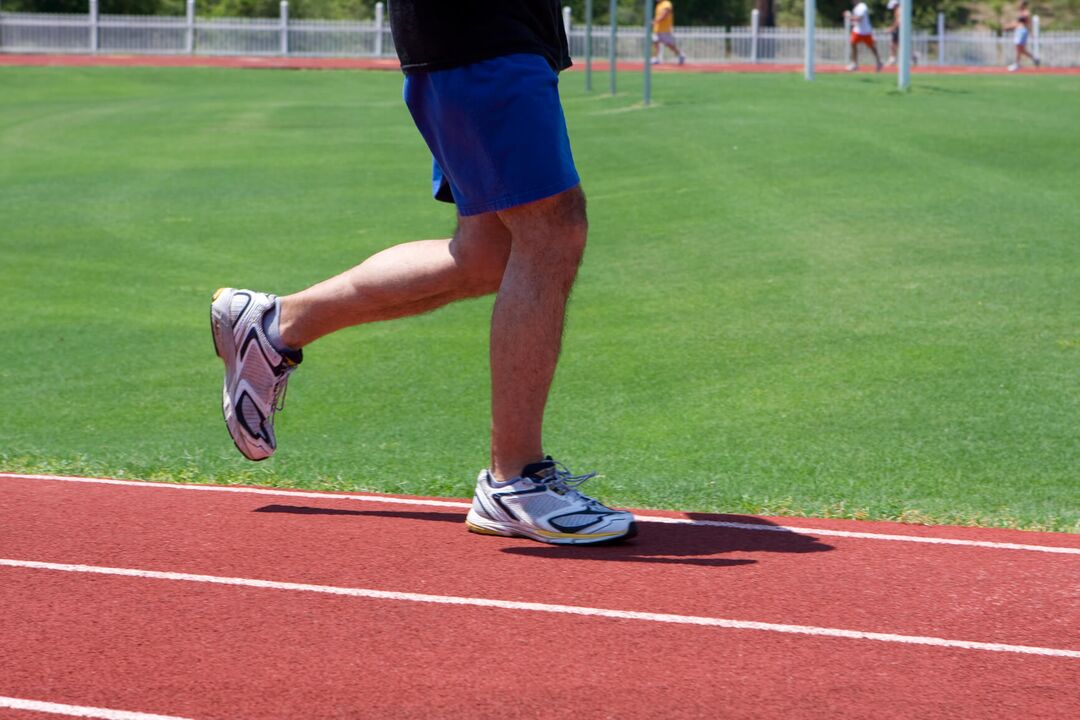
ProstatitisIt is a urological disease accompanied by inflammation of the prostate tissue. Damage to the prostate can be caused by an infection that is transmitted through blood, lymph or unprotected intercourse. The development of prostatitis in men is facilitated by injuries and disturbed blood supply to the pelvic organs, constant hypothermia, low physical activity, hormonal imbalance and other factors. Prostatitis can be accompanied by vesiculitis, urethritis and other infectious and inflammatory diseases of the reproductive and urinary organs.
Incidence statistics
Prostatitis is one of the most common diseases of the male genitourinary system in the world. According to various sources, it is observed in 60-80% of sexually mature men. According to official medical statistics, over 30% of young people of reproductive age suffer from chronic prostatitis. In approximately one third of cases, it occurs in men older than 20 and younger than 40 years. According to the WHO, urologists diagnose chronic prostatitis in every tenth patient.
Causes of prostatitis
Infections.Pathogenic and opportunistic bacteria enter the prostate through lymph and blood vessels. Secondary prostate infection is often a complication of inflammatory diseases of the rectum and urethra.
Types of infection:
- ascending- microbes rise to the gland from the outer opening of the urethra;
- down- Microbes enter the prostate along with the current of infected urine.
Conditionally pathogenic microorganisms that provoke the disease (according to the Research Institute of Urology 1997-1999)
| Microorganisms | Number of studies | |
|---|---|---|
| % | abs | |
| Staphylococcus epidermidis | 42. 3 | 55 |
| S. saprophyticus | June 17 | 23 |
| S. aureus | 4. 6 | 6 |
| S. haemolyticus | 3. 1 | four |
| S. hominis | 0. 8 | one |
| S. warneri | 1. 5 | 2 |
| Staphylococcus spp. | 3. 1 | four |
| Enterococcus faecalis | 11. 6 | fifteen |
| Streptococcus spp. | 3. 1 | four |
| TOTAL (gr. +) | 87. 6 | 114 |
| P. aeruginosa | 3. 7 | five |
| E. coli | 4. 7 | 6 |
| Enterobacter spp. | 2, 3 | 3 |
| Proteus spp. | 1. 5 | 2 |
| TOTAL (gr. -) | 12. 3 | sixteen |
Weakening of immunity.One of the causes of inflammation of the prostate is the weakening of the body's immune defenses. These can be alleviated by frequent stress, unbalanced diet, overwork, smoking, alcohol consumption. With reduced immunity, the body is most vulnerable to infections that lead to the development of prostate disease.
Blood supply disorders.The development of chronic prostatitis may be the result of a sedentary, sedentary lifestyle. With a constant lack of physical activity, the work of the endocrine, cardiovascular and nervous systems is disturbed, as well as the blood circulation in the pelvic organs. The result is starvation of prostate tissue with oxygen.
Irregular sexual activity.Both prolonged sexual abstinence and excessive sexual activity can contribute to the occurrence of prostatitis. Many men who are sexually active have nervous exhaustion, hormonal imbalance, impaired gonadal secretion, and a gradual weakening of potency. A broken relationship negatively affects prostate health.
Chronic prostate injury. . . Chronic prostatitis can develop as a result of frequent prostate soft tissue trauma. This is most commonly seen in patients whose professional activities are related to driving. The cause of prostatitis in this case is constant shaking, vibrations and excessive stress on the muscles of the perineum.
Major prostatitis syndromes
Pain.In prostatitis in men there are aches and pains in the lower abdomen and lower back, as well as pain throughout the body. This symptom may worsen with ejaculation, especially during intercourse after prolonged abstinence.
Dysuria. Typical signs of prostatitis in men are frequent urges to urinate, tingling and tingling when emptying the bladder, withdrawal pain after urination in the perineum. Another symptom of prostate inflammation is difficulty urinating. In the absence of treatment of the disease, acute urinary retention can occur.
Sexual dysfunction.In uncomplicated prostatitis, there is an accelerated ejaculation, wear and tear of orgasmic sensations, pain during ejaculation, partial or complete decrease in libido. Prolonged erection at night is also a symptom of chronic prostatitis.
External manifestations.In prostatitis, some patients have a purulent or clear discharge from the urethra, which is most common in the morning. Patients may also notice a symptom such as the presence of white flocks or threads in the urine.
Types of prostatitis
Acute bacteria.Acute prostatitis develops as a result of infection of the prostate with Staphylococcus aureus, Escherichia coli, enterococci and other pathogenic bacteria. If left untreated, this disease can cause blood poisoning. In this case, the man must be hospitalized urgently.
Symptoms observed in this type of prostatitis:
- chills and fever (38 ° C and above);
- sharp or dragging pains in the groin, lower back and perineum;
- frequent urge to urinate;
- painful urination;
- difficulty urinating and acute urinary retention;
- white or colorless discharge from the urethra.

Chronic bacteria.The recurrent form of the disease occurs as a result of the penetration of the infection into the gland. Chronic hypothermia, prolonged sexual abstinence and untimely urination contribute to the development of prostatitis. If left untreated, chronic prostatitis can cause cystitis because inflammation of the prostate is a reservoir of bacteria that affect the genitourinary tract.
Symptoms of chronic prostatitis:
- pain in scrotum, lower abdomen, perineum;
- dysuria;
- violations of potency.
Chronic nonbacterial.Causes of the disease include the penetration of viruses or bacteria into the prostate (tuberculosis bacillus, trichomonas, chlamydia), autoimmune processes, the penetration of urine into the gland. Chronic prostatitis accounts for up to 95% of all types of prostate inflammation.
Signs of prostatitis are:
- chronic pain in the pelvic area (torments a man for at least 3 months);
- recurrent groin pain;
- absence of symptoms of inflammation in urine, semen and prostate secretion.
Chronically asymptomatic.Asymptomatic chronic prostatitis is not associated with bacterial infection and symptomatic prostate syndromes. There is an assumption that this disease is an age-related physiological characteristic.
Symptoms of this type of chronic prostatitis:
- absence of major disease syndromes;
- increased content of leukocytes and bacteria in the urine.
The main symptom of the disease - the presence of an infection in the gland - can be detected only by biopsy or during surgery in the treatment of various pathologies of the prostate (adenoma, cancer).
He stagnates.Prostatitis develops not only against the background of anatomical and physiological changes in the venous and other bodily systems. The main cause of the disease is an irregular sex life.
Signs of prostatitis:
- excruciating pain in the perineum, radiating to the sacrum;
- increased urination in the morning;
- small difficulty in urinating (symptom is observed in the chronic form of the disease);
- weakening of the erection;
- decreased libido;
- "Paleness" of orgasmic sensations during ejaculation.
Diagnosis of acute and chronic prostatitis
To select the correct method of treatment, the doctor prescribes a comprehensive diagnosis of the condition of the genitourinary system, including the following methods.
Digital rectal examination.If prostatitis is suspected, a urologist conducts a digital examination. The posterior surface of the prostate is next to the rectum, so when the doctor inserts a finger through the anus, the doctor can determine the condition of the gland. During the research, its size, consistency and shape, surface condition, soreness are determined.
Signs of prostatitis in men include:
- soft, inelastic consistency of prostate;
- pain on palpation;
- enlarged gland;
- immobility of the rectal mucosa over the prostate.
Ultrasound procedure.Prostate ultrasound is prescribed before starting treatment for acute prostatitis to identify / exclude gland abscess, and in the chronic course of the disease - to identify cysts and stones of the prostate, as well as the degree of compression of the urethra. The most effective method is rectal ultrasound.
Uroflowmetry.This method of diagnosing prostatitis is used to study indicators of the urination process: the duration of this physiological act and the rate of urine outflow. If the velocity is 15 ml / s or more, this indicates normal urethral patency. A sign of prostatitis is a decrease in this value below 10 ml / s. This speed is due to poor urinary patency.
Interpretation of uroflowmetry results
| Urine flow rate | Interpretation |
|---|---|
| >15ml / sec | Urinary tract obstruction is unlikely |
| <10ml / sec | Narrowing of the urethra or weakness of the detrusor is likely to be significant |
| 10-15ml / sec | Indeterminate result |
Cystoscopy.For examination, an endoscopic imaging system is inserted into the bladder. This method for diagnosing acute and chronic prostatitis is used when diseases such as cancer, cystitis, or bladder trauma are suspected.
Laboratory research.To diagnose and determine the microorganism that caused the disease, in the presence of symptoms of chronic prostatitis or acute inflammation, urine and prostate secretions are examined. A sign of the presence of pathogenic microflora is an increased number of leukocytes in the biological material. To create an effective course of treatment, the type of bacteria is determined by PCR, RIF and inoculation on a nutrient medium.
Interpretation of laboratory results
| The secret of the prostate | Third urine sample (after prostate massage) | |||
|---|---|---|---|---|
| HP form | Leukocyte count, uv. x 400 | Sowing results | Leukocyte count, uv. x 400 | Sowing results |
| Bacterial | >10 | + | The difference between the number of leukocytes in the third part of the urine and the second part of the urine is ≥10 | + |
| Chronic inflammatory pelvic pain syndrome | >10 | - | The difference between the number of leukocytes in the third part of the urine and the second part of the urine is ≥10 | - |
| Non-inflammatory syndrome of chronic pelvic pain | <10 | - | - | - |
Prevention of prostatitis

Physical activity.To prevent and treat prostate disease, a man must avoid physical inactivity. Recommended:
- walking (4 km per day or more);
- exercise (squats, jumps, bending);
- perineum and buttock muscle training (10 tension and relaxation).
Proper nutrition.To prevent acute and chronic prostatitis, men should include in their diet foods rich in zinc and vitamin B. It is recommended to eat:
- seafood (oysters, algae);
- meat;
- pumpkin seeds;
- nuts;
- bran;
- kefir;
- Rye bread.
Regular sex life.When preventing and treating the disease, a man needs:
- lead a rhythmic sex life;
- avoid interrupted sexual intercourse;
- avoid casual connections.
Treatment of acute and chronic prostatitis
Inflammation of the prostate is treated by the following methods.
Antibacterial therapy.If prostatitis is bacterial, antibiotics are needed to treat it. The doctor selects a group of drugs depending on the type of microbes that caused the disease, the sensitivity of the pathogen to different drugs and the presence of contraindications in the patient.
Characteristics of drugs
| Drugs | Advantages | shortcomings |
|---|---|---|
| Fluoroquinolones |
|
|
| Macrolides |
|
Insufficiently active against gram negative bacteria |
| Tetracyclines | Active against atypical pathogens |
|
Hormone therapy.Hormone treatment is necessary to establish a normal hormonal balance between androgens and estrogens. Drugs with antiandrogenic action reduce inflammation of the glandular tissue and prevent the disease from progressing to more severe stages.
Prostate massage.This method of treating chronic prostatitis can only be used outside of exacerbation. The man should take a position, rest his palms on the couch or table, spread his legs shoulder-width apart. The doctor who puts the treatment puts sterile gloves on his hands, applies ointment or gel (in some cases a medicine with an anesthetic component) to the index finger of his right hand and injects them through the anus into the rectum. The massage is performed with light pressure until the prostate secretions separate through the opening of the urethra. The treatment includes at least 10 massage sessions.
Physiotherapy.Methods for normalizing and increasing blood circulation in the pelvic area are used to treat the symptoms of prostatitis. This allows you to eliminate stagnation, as well as increase the effectiveness of drug therapy. The treatment is performed by exposing the gland to ultrasonic waves, electromagnetic vibrations, as well as high temperatures (microclysters with warm water).
Surgical intervention.Surgical interventions in prostate disease are rarely used. Such treatment is mandatory for the development of complications of acute or chronic prostatitis.
Indications for prostate surgery:
- acute urinary retention as a result of severe urethral narrowing;
- abscess (appearance of suppuration on the surface of the gland);
- sclerosis of the gland;
- an adenoma that does not respond to conservative treatment.
Complications of prostatitis

Vesiculitis.Untreated prostatitis can cause inflammation in the seminal vesicles. Symptoms of the disease are pain deep in the pelvis, radiating to the sacrum, intensified by erection and ejaculation, frequent urination, the appearance of blood and / or pus in the semen and urine.
Coliculitis and urethritis.Due to the proximity of the excretory ducts of the prostate, seminal tubercle is often inflamed as a result of infection of the infected gland. If left untreated, the symptoms of prostatitis are supplemented by a characteristic symptom of urethritis - tingling or tickling in the urethra when urinating. There is also pain during ejaculation as a result of spasmodic contraction of the urethra.
Prostate abscess.The appearance of purulent cavities on the surface of the gland is due to pathogenic bacteria that have caused prostatitis. The characteristic symptom of the disease is general weakness, impaired consciousness, delirium, sudden rise in temperature, increased sweating, chills. Prostate abscess is a severe septic disease that must be treated in a hospital.
Prostate sclerosis.Prostate sclerosis develops against the background of regular exacerbations of chronic prostatitis as a result of non-compliance with the treatment prescribed by a urologist. This disease can form over several years, however, if the hormonal balance in a man's body is disturbed, rapid development is possible. With prostate sclerosis, pain is observed during bladder emptying, intermittent and sluggish urine flow.
Creation of cysts and stones. . . The appearance of cysts in the gland is one of the probable options for the progression of chronic prostatitis. Infection with neoplasms can cause an abscess and greatly complicate the treatment of the disease. Single and multiple stones can also form in the prostate. In this disease, in addition to the usual symptoms of chronic prostatitis, there are violations of the outflow of urine, frequent urination, pain in the perineum.
Infertility.In chronic prostatitis, sperm production and motor function are impaired. If left untreated, the disease affects both your deferens and seminal vesicles, making them impassable for sperm so that they are not thrown into the urethra during ejaculation. As a result, men who have chronic prostatitis often suffer from infertility.



























